In a bold move, Netflix has announced a rise in prices across various subscription plans in the United States. This decision reflects not only the company’s strategy to enhance revenues but also illustrates broader trends within the streaming industry. As Netflix adjusts its pricing structure, it is crucial to explore the implications for its subscribers, competitive landscape, and future growth.
Netflix’s announcement outlines a significant increase in costs for its popular services. The standard plan without commercials will rise from $15.49 to $17.99, while the newly introduced ad-supported plan will see a minor bump from $6.99 to $7.99. Furthermore, the premium plan’s price will escalate from $22.99 to $24.99. Such price adjustments are not unique to Netflix; they signal a broader market shift as streaming services combat financial challenges and strive for profitability.
The decision to boost prices is influenced by several factors, including content production costs, market competition, and a need to enhance shareholder value. The streaming market has become crowded, with emerging players providing alternative viewing platforms that compel established companies like Netflix to adapt. Notably, rising production costs have been a persistent concern, prompting the need for these additional financial inputs from subscribers.
The streaming industry, once defined by low prices to attract subscribers, is experiencing a transformation. Companies like Disney and Warner Bros. Discovery are grappling with similar challenges. Various platforms have resorted to introducing ad-supported models or increasing subscription fees to generate revenue. However, while some competitors have opted for a gradual approach to price increases, Netflix has taken a more direct path, escalating costs across its multiple plans almost simultaneously.
Netflix’s co-CEO Ted Sarandos justified these hikes by emphasizing the importance of offering top-tier content as a rationale for consumers’ willingness to bear increased costs. He pointed out that the company is gearing up for significant releases in 2025, which is critical for maintaining engagement and preventing subscriber attrition. Quality content, paired with marketing push and extensive viewership data, remains vital for the platform’s longevity in a competitive arena.
While the price hikes may alarm current users, it’s essential to recognize that Netflix is banking on its content library and a strategic launch schedule to retain subscribers. Historical data reveals that subscribers tend to tolerate moderate price increases if accompanied by the promise of quality content. The recent surge of 19 million paid memberships reported in the fourth quarter underscores this point – potentially indicating that viewers are willing to invest if they perceive substantial value.
Moreover, Netflix’s recent crackdown on password sharing indicates an adaptive strategy to bolster its revenue base. By providing the option to add “extra members” at an additional cost, Netflix has sought to capitalize on shared accounts while simultaneously migrating non-paying users towards a more financially productive subscription structure. This approach not only generates additional revenue but also addresses the fundamental issue of account sharing that likely undermines subscriber growth.
As Netflix commits to its new pricing structure, questions about its long-term implications linger. The company’s recent introduction of ad-supported plans represents a noteworthy pivot, potentially heralding a new era in which traditional subscription models become more flexible. With strong expectations for upcoming content and a continually expanding user base, the streaming giant must maintain a delicate balance between profitability and subscriber satisfaction.
Netflix’s recent price hikes illustrate the dynamic and increasingly competitive landscape of streaming services. By focusing on viable content, enforcing new business strategies, and responding to market needs, Netflix aims to not only justify its price increases but also maintain its position as a leading entertainment platform. It will be crucial for the company to remain attuned to subscriber feedback and market changes as it navigates the complexities of this evolving sector. As of now, with a growing subscriber base and upcoming content, Netflix appears poised for continued success, albeit with careful management of its pricing strategies.

